Transform from Monolithic to MACH
.png)
What is MACH Architecture?
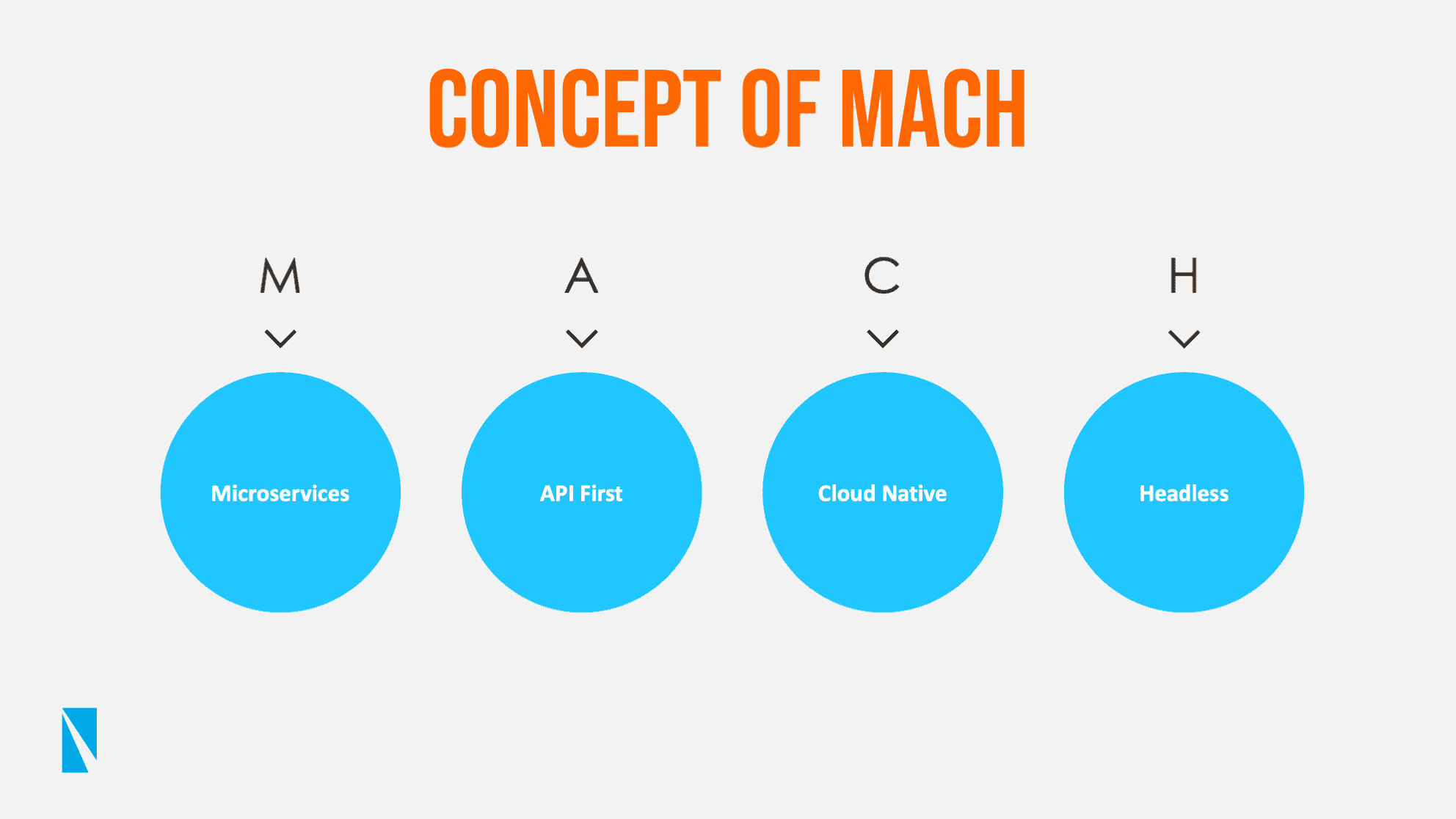
MACH is a term coined by commercetools, which emphasizes creating an eCommerce platform that works purely on the cloud with Microservices, and APIs and is Headless. So, ideally, it should be developed, tested, and maintained on the cloud.
Now, let's break down each component of MACH to understand how it contributes to creating the MACH eCommerce platform.
Microservices Architecture
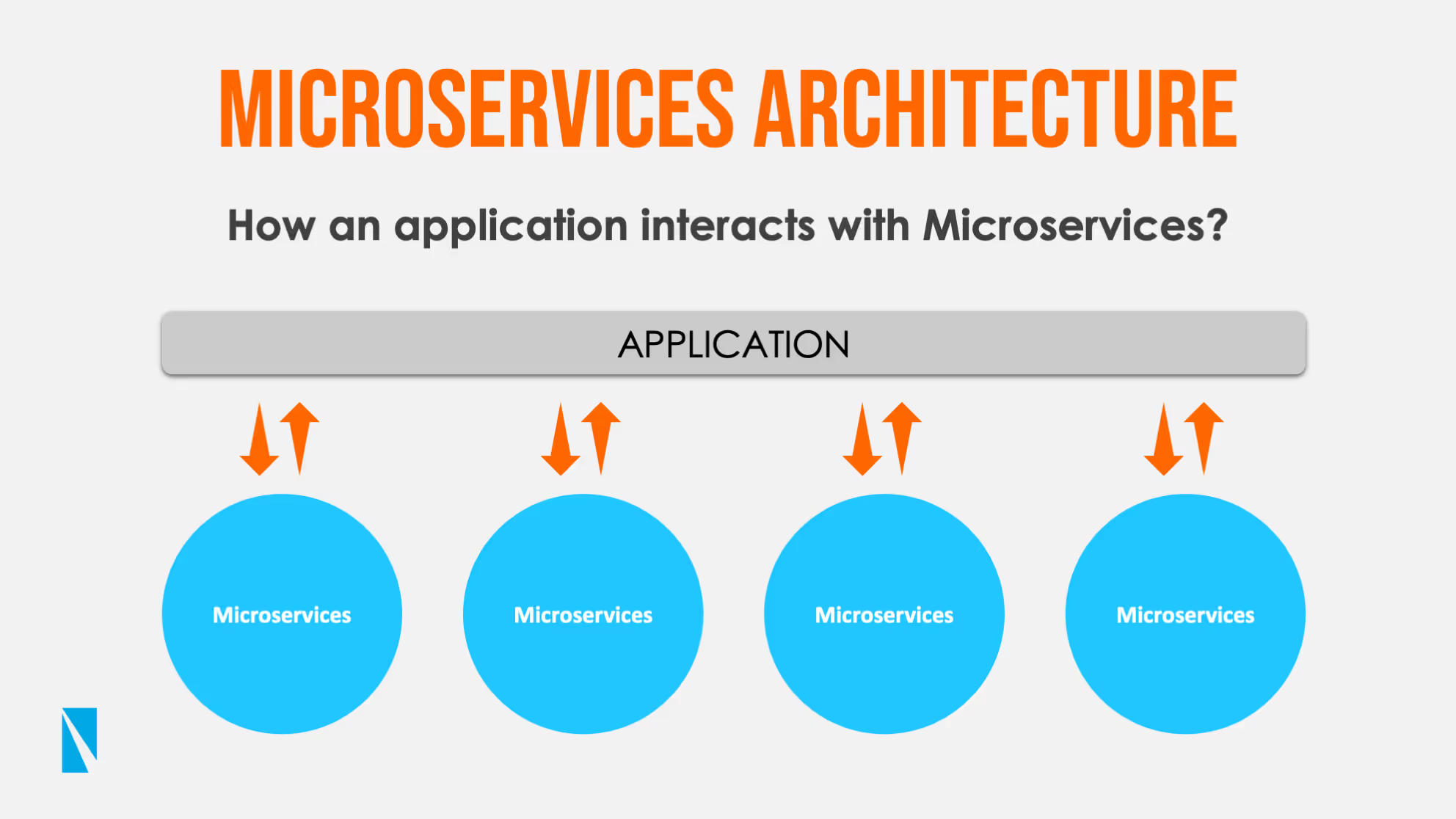
Microservice architecture pattern breaks down a huge monolithic application into manageable chunks of services. In addition, Microservice architecture enforces a level of modularity. Consequently, individual services are much faster to develop, understand and maintain. Moreover, the developers can have the liberty to choose the different technologies for different microservices based on cost, efficiency, and soft skill set.
Microservice can be deployed independently. As soon as the service is tested locally, it can be deployed.Consequently, microservice makes continuous deployment possible.
Finally, the most important feature is that each service can be scaled independently.
API-firstApproach
Before starting with actual backend code, an API-first approach first focuses on starting with design, planning, mocks, and tests.
With the API-first strategy, stakeholders in the project can share feedback at this early stage, which allows teams to make changes more efficiently before a lot of time and effort is sunk into the project. Due to this feature, application development using the API-first approach saves precious development time and the launch of the application to market.
‘Cloud-native’Technology
The 'Cloud-native' technology is an approach to designing, constructing, and operating a collection of small, independent, and loosely coupled services. Such Cloud built applications take full advantage of the cloud computing model. Cloud platforms provide features of reliability, scalability, and flexibility while giving the option of Paying as per usage with no maintenance responsibility.
Microsoft, Google, Amazon, and Oracle provide the Cloud environments.
Headless
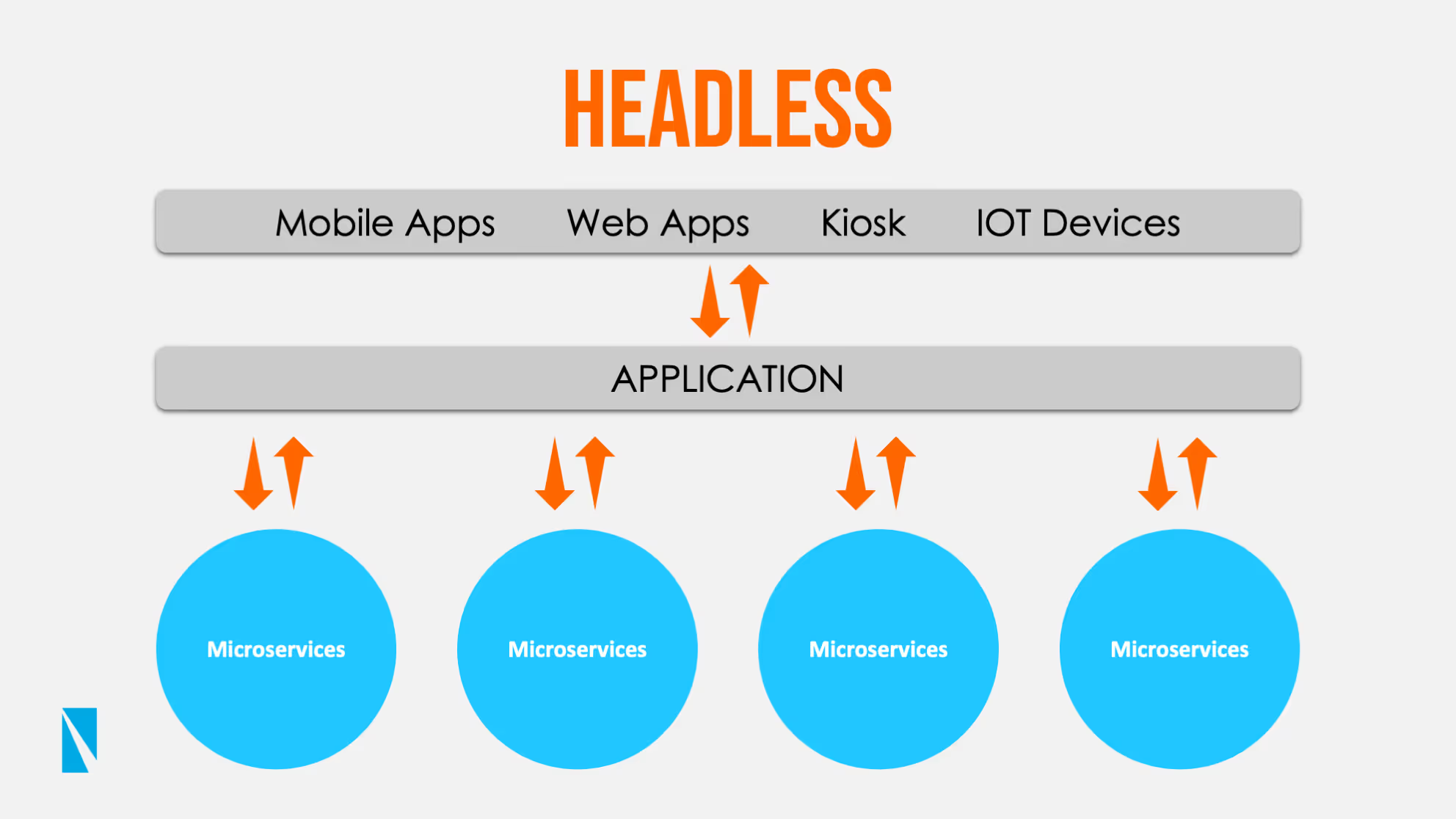
Headless represents the decoupling of the frontend and backend. Backend APIs can be accessed by all kinds of frontend like web, mobile, IoT devices, Kiosk, or any other third-party apps.
Why MACH?
Pain points of Monolith
Over time projects become massive monoliths tightly coupled with intricately connected functionality.
Costs to maintain the system increase, and changes are increasingly slower to make; production issues and bugs create a vicious cycle that blunts the competitive edge.
- Expensive licensing costs justify the enormous functionality. Unfortunately, many "Cloud Solutions" are also just glorified monoliths.
- Difficult path to headless architecture due to tight coupling of functions.
- Inefficient test process is inevitable in such complex systems. It is a perfect habitat for bugs and production issues.
- Managing people in large teams require higher coordination overhead.
- People in teams are increasingly generalists as they need to squat bugs everywhere.
- Reduced specialization of people leads to a lack of innovation.
- Lack of clearly defined modules' ownership creates ever-increasing technical debt.
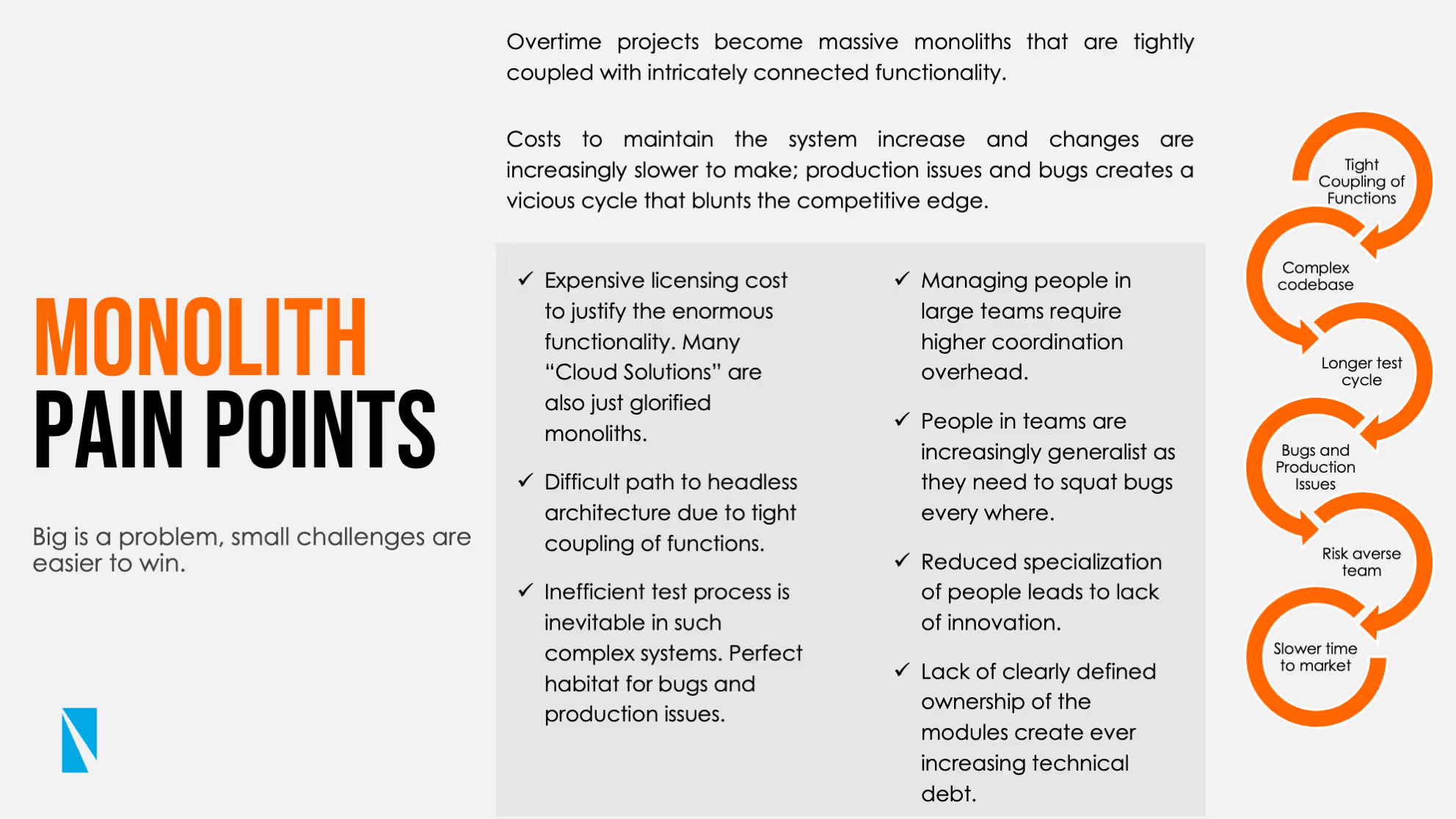
Is MACH the Utopia?
Modern Commerce framework has certain pain points. Emerging paradigms need the expertise to avoid obvious stumbling blocks.
- No one-stop solution: One needs to assemble the solution from available options with their own merits based on the “suitability” of the business needs and wants.
- Plague of the versions: Supporting multiple versions of different microservices based functions in a system can quickly make the system crawl to its knees. This problem is solved at the architecture level, not by extra effort.
- Sprawl of the Microservices: Microservices architecture, if exposed, will take some effort to understand and implement in the right manner, or else it can become costly to run.
- Headache of the multiple heads: Creation of multiple heads from scratch is a pain if not managed appropriately.
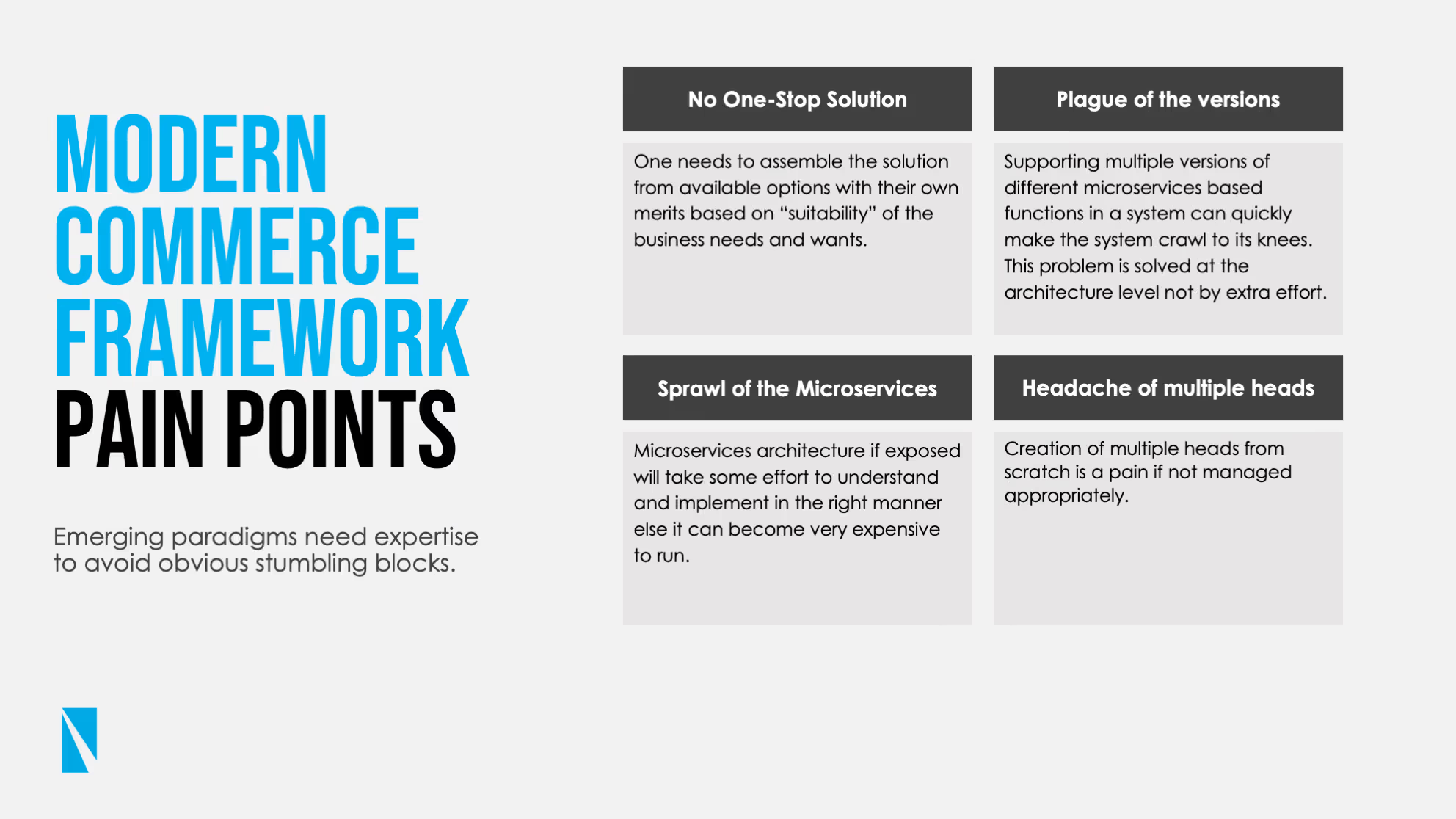
Migrate to MACH
Now that we have seen the benefits and issues of creating an eCommerce on MACH, one needs to understand how one can move from a monolithic architecture to a MACH based eCommerce platform. So in this blog, we present simple steps for transformation from the existing ATG/Hybris eCommerce platform to a MACH-based commercetools Platform.
This migration process requires solid technical and analytical skills. These points are highlighted in the flowchart below. Later, each topic is explained in more detail.
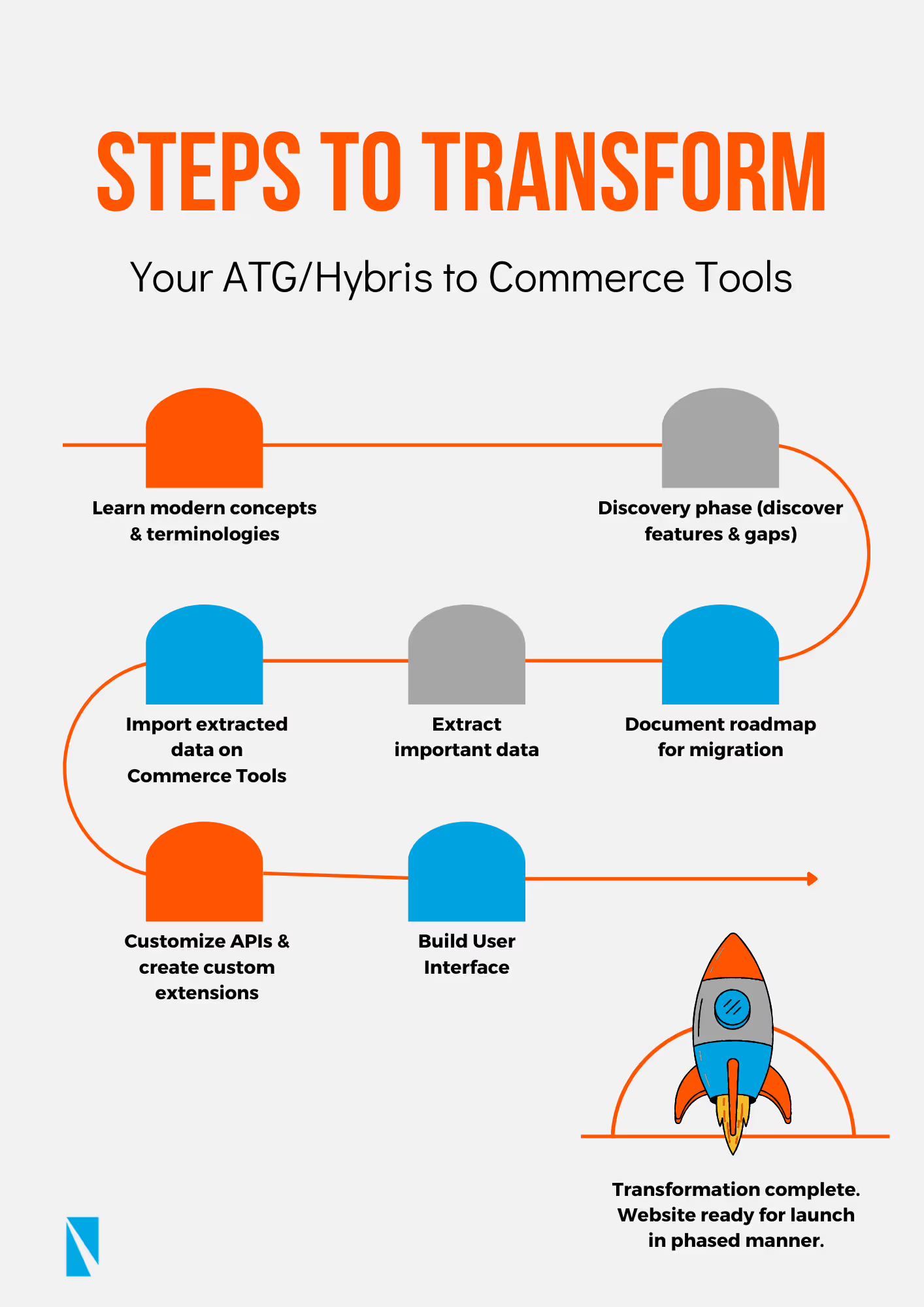
Following is the in-detail approach in each step that needs to be taken for transformation: -
Learning Modern Concepts and Terminologies
Make sure your team knows about modern advancements and implementations of Microservices, Public cloud, Container ecosystem, DevOps, and Agile development methodologies. This will make sure that your team will be able to do development and understand the minute details of the implementation of commercetools.
Discovery Phase (Discover Features & Gaps)
Certain processes would be readily present from OOTB commercetools, while some features would have to be migrated from your existing systems. So, a thorough analysis is required to document the features and gaps. Then, a priority of processes that can be readily transferred or are available OOTB can be taken care of immediately. At the same time, other time-consuming and less critical features can be planned to migrate in a later stage.
Document Roadmap for Migration
Break down all important lists of features under headings of “Milestones with Strict timelines” to achieve them. This ensures that the team will work together with a fixed goal during the migration process.
Extract Important Data
Extract all necessary important data related to content catalog and product catalog from ATG/Hybris into an XML/CSV. Extract important datatypes in the Product Catalog for Categories / Category Tree, Products & Skus / Variants
Import Extracted Data on Commerce Tools
The extracted data needs to be arranged in proper sequence, which can be easily imported into commercetools using Data Migration Service.
Customize APIs & Create Custom Extensions
Learn to extend and customize the APIs you use, as the APIs consumed are hosted by commercetools, unlike other Monolith eCommerce platforms. commercetools continually push changes to production, often four times a day or more.
Build User Interface
The user interface will be the only module during the migration process that needs to be built from scratch, possibly due to the strong coupling of UI code with backend code. Most of the pages used in ATG/Hybris may not be helpful with the commercetools backend. Build the frontend UI solutions as per the expertise of your frontend UI team so that users get a seamless surfing experience while shopping on your brand's website.
Tweak the above steps (if needed)
Migration/Transfer steps may be tweaked for each brand to make the transfer process more efficient and time-saving. This makes sure that your brand store is launched.
Stay Patient and Focused During Entire Migration Process
One needs to be patient during the entire process because, at times, such technology transfer from one platform to another can take anywhere from 3 months to 2 years. If too many custom applications exist in your existing application, your migration process will take more time and effort.
Also, the transfer time will significantly reduce if the custom applications or 3rd Party APIs are easily on the MACH platform.
Another aspect that will play a key role in the migration process will be UI. Again, time and effort will depend on its customizations and features.
Achieve MACH. Let's Dive into Creating a Future-ready platform in the shortest time.
In our fast-moving world, eCommerce businesses often face bottleneck competition from their peers. So it becomes critical for them to create their online brand store in the shortest timespan while ensuring that their platforms are scalable, low in maintenance, and easy to customize. Moreover, engaging customers digitally and delivering them personal experience is essential. Such future-ready platforms should fulfil the criteria of MACH (Microservices, API-first, Cloud-native, Headless).
One such platform that caters to the Criteria of MACH is commercetools. A commercetools project can be implemented in as little as 6-8 weeks. Its Microservices (API) based architecture provides a "building blocks"approach that can be customized to the business and its unique brand.
Build B2C Businesses
Engaging customer experience is key to better conversions, and with commercetools, one has strong control over it, thus making sure that customers engage more with your site.
For B2C businesses, functionalities of product catalogs, orders, customer profiles, etc., are readily available. Therefore, it is built as a cloud-native, headlessc ommerce platform with a highly versatile API at its core.
Build B2B Businesses
For B2B eCommerce, customers now expect the same convenience and engaging experience with B2B that they get from B2C.
For B2B businesses, readily available functionalities are user administration tooling, allowing people to administer their product catalog, promotions/discounts, customer profiles, and orders.
D2C Businesses
For Direct to customer business, there are newer innovative ways to enrich the shopping experience. One of the ways is connecting your customers through social media channels, which makes sure that they are aware of the latest innovations being driven by your brand, which drives customers to get on board with your brand.
Is MACH Better Than A Monolithic Platform? A Simple Yes or No Will Not Serve.
After looking into so many advantages of MACH over monolithic, shouldn't brands rush towards a MACH platform? But, as we said, A simple YES or NO won't be the proper answer. Mainly because so many factors play a crucial role in deciding which platform will work best depending on the customs features, 3rd party API configuration options available with each platform, cost, and soft skills availability.
Creating eCommerce on a monolithic can sometimes be simpler, mainly because all components are already coupled. This reduces the time spent on creating UI or backend implementation.
New Reference Architecture
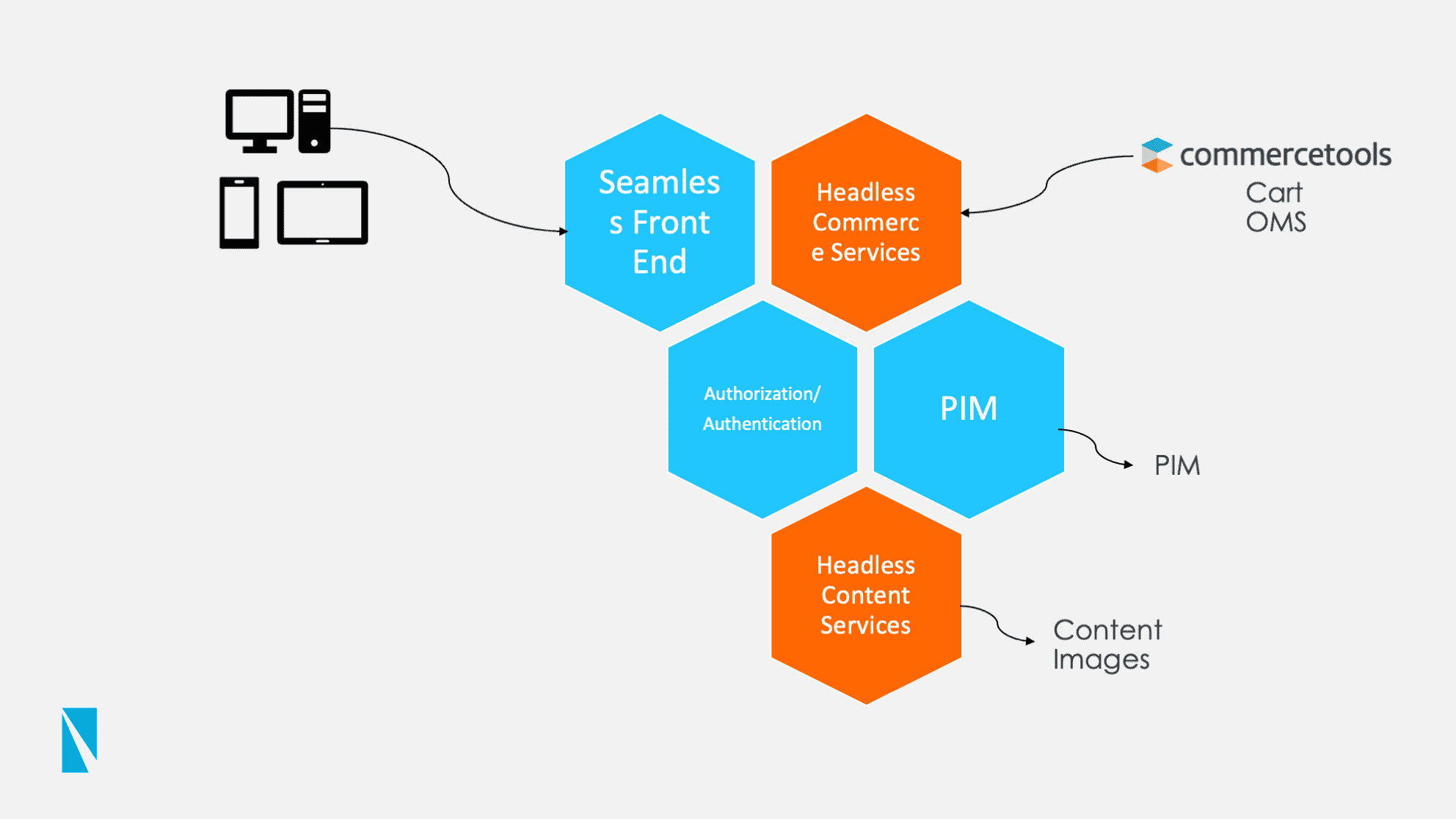
Gear up. It's time to launch your online store.
Do these eCommerce advancements make you excited to launch your e-brand? Of course, but before diving into it, you would like to know if going ahead with Hybris/ATG/commercetools can be a better fit for your business.
Do not worry; With Nvizion Solution’s expertise in eCommerce, we will help you choose the best platform for your business.
So, connect with us, and we will guide you in each step and help you launch a successful E-commerce website.
Faq
How is MACH different from a monolithic architecture?
- MACH stands for Microservices, API-first, Cloud-native, and Headless.
- Monolithic architecture is one big, tightly connected system where everything (frontend, backend, logic) is bundled together.
· MACH is different because:
It breaks systems into small, independent services (microservices)
· Everything connects via APIs
· It’s designed for the cloud
· The frontend and backend are decoupled(headless) so you can choose any UI tech you want.
In short: MACH = flexible, modular. Monolith = one big block.
Why should businesses migrate from monolithic to MACH architecture?
Businesses migrate to MACH because it allows them to:
· Adapt faster to market changes
· Launch new features without big code rewrites
· Scale specific parts of their business independently
· Integrate best-of-breed technologies
· Offer personalized, modern customer experiences across channels
Monolithic systems often slow innovation because changes in one area can break the entire system.
What are the benefits of using commercetools for MACH transformation?
Commercetools is a leading MACH commerce platform. Benefits include:
· True headless commerce, letting you design any frontend experience
· Flexible APIs to connect easily with other systems
· High scalability for global businesses
· Faster time to market for new products or channels
· Lower long-term maintenance costs compared to monoliths
It’s a powerful choice for businesses wanting future-proof commerce.
How long does it take to migrate from Hybris/ATG to a MACH platform?
It depends on your business size and complexity:
· Small-to-mid projects: ~4-6 months
· Complex enterprise projects: 9-18 months or more
Factors affecting time:
· How much data and business logic you’re migrating
· Custom features in your current system
· Frontend redevelopment requirements
· Integration with other systems (ERP, CRM, etc.)
Can I reuse my existing frontend UI with a MACH platform?
Sometimes, yes, but with caveats.
· If your frontend is built to be modular and can call APIs, you may reuse it partially.
· Many monolithic frontends are too tightly coupled to the old backend, so rebuilding or refactoring is often needed.
MACH gives you freedom to keep your frontend tech stack but you’ll likely need adjustments to integrate with new APIs.
Insights
Looking for resources, tools, tips and industry news? Stay ahead of the curve with quick access to thought leadership and expert insights on digital transformation.
